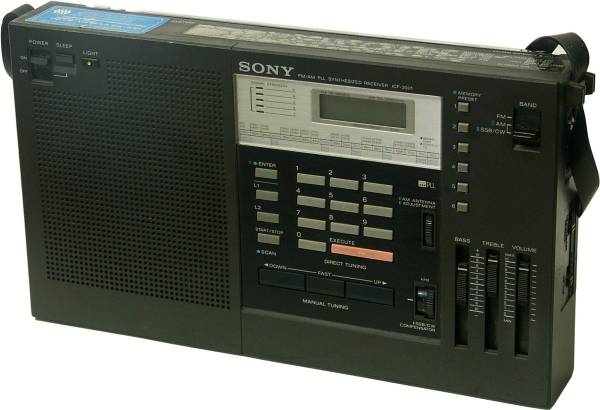Inhaltsverzeichnis
Sony ICF-2001
Manufactured by Sony, Tokyo.
When Sony introduced the first microprocessor-controlled shortwave receiver in 1980, it was an absolute innovation in the design and concept of shortwave travel radios. For the first time in a travel portable, direct frequency input via a numeric keyboard was realised in the ICF-2001.
The set couls still improved somewhat, so Uniden brought out the CR-2021 a some years later, and Sangean developed the immensely successful ATS-803 with similar specifications like the ICF-2001. Sony countered with a set whose performance on the shortwave bands and innovative features remain unrivalled to this day, at least no set from another manufacture has surpassed its performance: in Europe, the set was got the designation ICF-2001D. a model number which was difficult to distinguish from the '2001, in Japan and the USA the difference was clearer with the model designation ICF-2010.
Technical data
- Frequency range: VHF, AM 150 kHz - 30 MHz
- Frequency display: Digital display 1 kHz
- Frequency memory: 6 memories
- Signal strength indicator: LED chain, 5 steps
- Features: digital clock, sleep timer
Power supply
- Mains operation: 220 V via mains adapter 4.5 V (AC-122, three switchable voltages or in Europe AC-140W, 4.5 V, blue colour)
Dimensions
- 310 x 170 x 56 mm, weight 1.8 kg
Accessories
Operation
This travel portable is still quite large by today's standards with it's 31 x 17 x 5.6 cm , and it's weight of 1.8 kg is considerable. But in 1980, double conversion sets with digital frequency display had a strong carrying handle and suitcase format. Technically, standard conventional receivers were single conversion superhets connected to a frequency counter - and the ICF-2001 was microprocessor controlles with a PLL synthesizer.
The receiver (included its display illumination) is powered by three UM-1 „D“ cells, two further UM-3 „AA“ batteries are needed to retain the memory contents. Alternatively, the receiver, which was known to be very hungry for batteries, could be powered from a 4.5 V power supply or a special adapter cable from the car battery. The main switch, which is somewhat recessed, and the buttons for the 90-minute sleep timer and the display illumination are located above the speaker grill.
In the middle of the front panel the digital LCD frequency display is located, next to it the signal strength indicator with a five-part LED chain, below it the numeric keypad for direct frequency entry, the Enter key, the keys for the scan functions (L1 and L2 for entering the upper and lower limits and START/STOP for said…) and at the bottom the tuning keys UP / DOWN, pressing the middle tuning key accelerates the tuning speed. At the beginning, the shortwave listeners community had to get used to this type of tuning, Sony was blamed for the lack of a „real“ tuning knob, today a tuning knob is only found on a minority of radios.
For the first time, the ICF-2001 also offered direct frequency entry: after entering the frequency with the numeric keypad, pressing the red EXECUTE button automatically tunes the set to the desired frequency.
Small knurled controls are used for antenna adjustment and fine tuning, this is especially useful in CW / SSB reception. On the right side of the front panel, you find the frequency memory keys (recall memory by pressing the key, store by pressing ENTER and the corresponding memory key), the mode switch with the positions FM (for VHF), AM (for the other ranges) and SSB/CW for activating the BFO for receiving Morse and amateur radio signals.
Three slider controls serve as bass, treble and volume controls.
The sockets for earphones, line out and for cassette recorder control for automatic recording are located on the right face, also the socket for the external AC-140W power supply.
From today's point of view, the reception performance of the ICF-2001 can still be considered as good for a travel portable, but it is far surpassed by the ICF-2001D. The original ICF-2001 had only 6 station memories, which may seem quite few today, but compared to one single operation frequency, it was an enormous improvement.
Even though the set is still a useful travel companion today, the smaller travel receivers from Sonys 7600 series offer advanced technology in a smaller cabinet and have a useful alarm function, the ICF-2001D is a much better choice for the ambitious shortwave listener thanks to its selectable bandwidths, better IF filters and especially the automatic ECSS demodulation - since both sets are only available second-hand, it is worth looking for an ICF-2001D on Ebay right away.
It has been reported that the ICF-2001 often has problems with the memory batteries, especially if the battery compartment has been damaged by leaking batteries or if the connection between the battery compartment and the printboard is poor.
Technical principle
Double conversion superhet, microprocessor control with PLL synthesiser
Components
The set is equipped with semiconductors.





